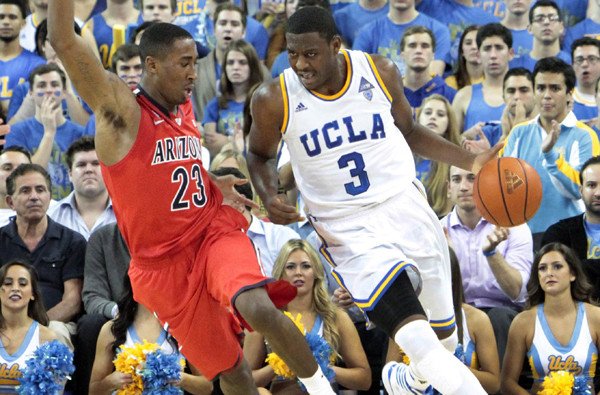History Lesson: What 2014 UCLA Can Learn From 1994 UCLA’s Loss Against Tulsa
Posted by Andrew Murawa on March 21st, 2014When UCLA hosts Tulsa this evening in San Diego, the Bruins will be solid favorites over an upstart Golden Hurricane team, much as they were 20 years ago when they lost to a Tubby Smith-coached Tulsa team that advanced to the Sweet Sixteen before eventually losing to national champion Arkansas. Below, we’ll compare a few areas where that 1994 team failed with what this year’s UCLA team needs to do in order to advance to Sunday’s round of 32.

Shea Seals, Here Stealing The Ball From Charles O’Bannon, Helped Tulsa To A First-Round Win Over UCLA in 1994
Show up ready to play. No offense to that talented Golden Hurricane team of 20 years ago, but it was clear from the start that UCLA did not show up ready to play. The Bruins didn’t take their opponent seriously prior to the game (I believe the quote was: “Tulsa – where’s that?”) and once the game did start, their defensive effort was lackluster at best in the halfcourt, while in transition it was even worse. Priority number one for Steve Alford is to avoid any repeats of games like the regular season finale at Washington State where the team basically confessed that it focused on the task at hand. Roll out tape of the Wazzu game; roll out tape of Tulsa 20 years ago; do what you gotta do, but make sure everybody is focused on this game and this game only. Coming off Saturday afternoon’s emotional Pac-12 Tournament win over Arizona, everybody needs to be able to duplicate that energy and take James Woodard, Rashard Smith, Shaquille Harrison and company as seriously as they took Nick Johnson, Aaron Gordon and T.J. McConnell.
Knock down outside shots. Twenty years ago, Tubby Smith’s team packed their defense in, jumped into a zone most of the night and forced UCLA to hit outside jumpers. Let’s just say that did not go well for the Bruins. While this vintage of the Golden Hurricane is far less likely to drop back into a zone, expect UCLA to have plenty of good looks around the perimeter against a team that isn’t great in challenging perimeter shots. Guys like Jordan Adams (36.1% from three), Zach LaVine (40%), Bryce Alford (39.5%) and the Wear twins (a combined 46.2%) are going to have their share of looks from the outside. Knock in those shots at a rate commensurate with their season-long averages and the Bruins are probably fine. Dip down into the low 30s or worse as a team and that’s a recipe for problems.

Jordan Adams’ Perimeter Shooting And Ability To Create Turnovers Will Be Big For UCLA’s Chances (Lawrence K. Ho, Los Angeles Times)
Create transition opportunities. As hard as it may seem to believe, despite the fact that the Bruins scored 102 points in the loss 20 years ago, their defense did not regularly create opportunities for their offense. This time around, guys like Adams, Kyle Anderson and Norman Powell will have to step into passing lanes, poke away loose balls and otherwise find ways to turn the fairly tight-handled Hurricane over. When the Bruins are at their best, they’re creating steals on 13 percent of all defensive possessions, which not only limits the effectiveness of their opponents, but jump starts the vaunted UCLA fast break.
Get to the line. Twenty years ago, Tulsa made 35 free throws against the Bruins (in 47 attempts), while UCLA only attempted 16 (making 13). This time around, those numbers had better be far more equal. While the Bruins as a whole aren’t particularly adept at getting to the line (they’re 210th in the nation in the rate of free throw attempts compared to field goal attempts), they also don’t foul too often. But given that there are quite a few players on the Golden Hurricane capable of going at and getting by their man on the offensive end, it is going to be imperative that UCLA does not begin a parade of Tulsa players getting free looks from the charity stripe. UCLA doesn’t need to own this particular stat – they’d be just fine with a draw here – but they can’t get dominated like they were in 1994.










































